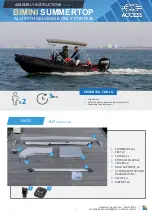
SVC 7- 13
Troubleshooting and Maintenance
Chromatographic Symptoms
Troubleshooting valves and their related plumbing is primarily a matter of systematic checking and veri-
fication of unimpaired mechanical operation of any moving part. This requires an understanding of how
the valve functions internally and how the plumbing is configured. A plumbing diagram is essential for
effective troubleshooting.
The following “symptom- cause”list gives the most commonly encountered problems found with valves
and their solution.
Loss of Sensitivity or Excessive Drift
Several possible causes exist for overall deterioration of the chromatogram.
D
Contamination in the valve requires a thorough cleaning.
D
Internal leakage necessitates a complete disassembly and inspection of the mating surfaces.
D
Poor temperature control may require a full check of electronic and thermal components.
D
Lack of proper conditioning techniques, columns, etc.
D
Failure or deterioration of other components (i.e., columns, detectors, etc.).
Loss of Peaks in Specific Areas of the Chromatogram
Entire sections of chromatographic data can be lost due to a valve that does not rotate or one that ro-
tates improperly. Other than obvious component failures (i.e., solenoid, actuator, etc.), generally im-
proper adjustments and misalignments cause most problems.
D
Check that adequate air (about 482 kPa or 70 psi) is supplied.
D
Check the valve. Is it rotating?
D
If the valve rotates, check for proper alignment of the actuator, mechanical binding or slippage
of connecting parts.
D
Check for blocked flow paths with valve in both positions.
Baseline Upsets
Frequently baseline upsets may be seen on chromatograms when valves are switched. These upsets
are normally caused by pressure changes within the system, injections of large volume samples, or by
changing the amount of restriction in the flow path. These upsets will become more of a problem when
high sensitivity is required. Addition of a fixed restriction downstream from the valve may help minimize
the upset. Changes in column length may also help reduce the upsets.
Fixed restrictors are used immediately before flame detectors to prevent flameout and are used in some
instances to prevent pressure surges from damaging TCD filaments. An adjustable restrictor (needle
valve) can also be used where a matched restriction is desired but not for preventing pressure or flow
surges.
Artisan Scientific - Quality Instrumentation ... Guaranteed | (888) 88-SOURCE | www.artisan-scientific.com
















































